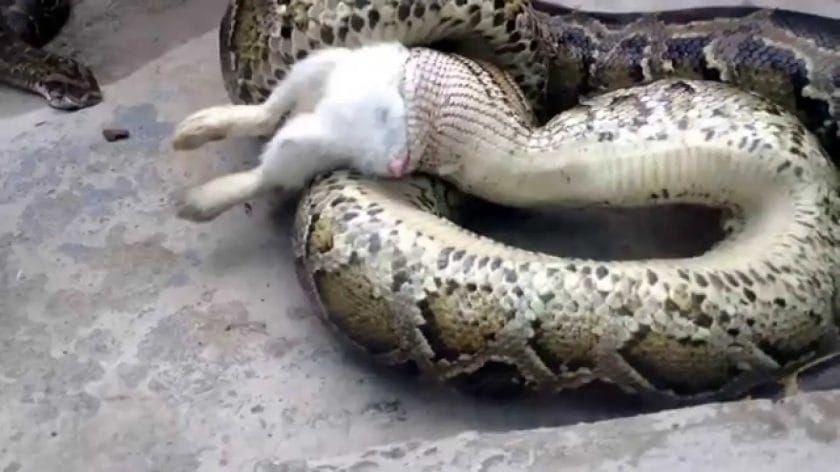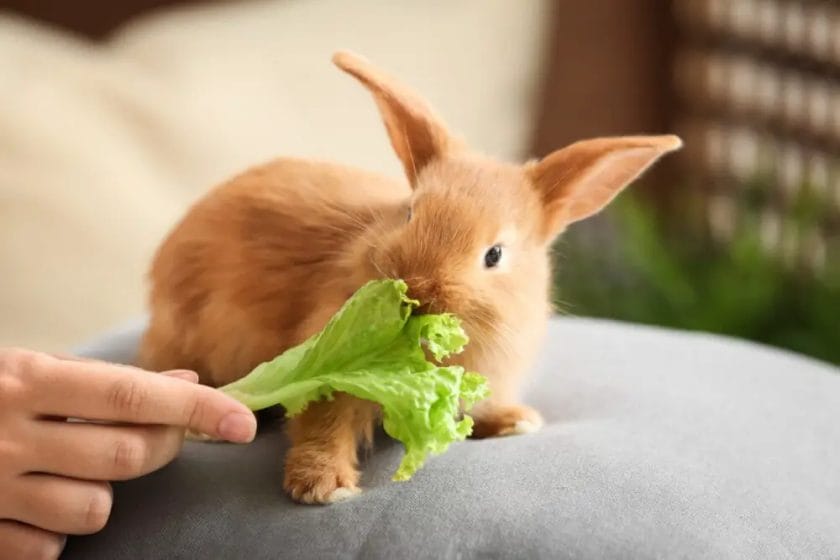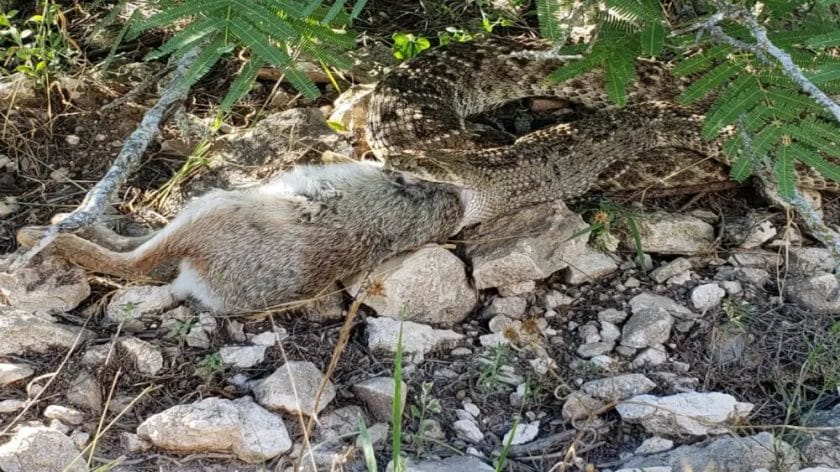Yes, snakes are known to eat rabbits. Snakes are carnivorous reptiles and their diet primarily consists of small animals, including rabbits. With their unique ability to swallow prey whole, snakes are able to consume animals larger than themselves.
Rabbits, being herbivorous animals, are not the main target of snakes. However, if the opportunity presents itself, snakes will not hesitate to capture and devour a rabbit as a source of food.
It’s important to note that not all snakes can eat rabbits, as their size and hunting techniques vary. Large snakes, such as pythons and anacondas, are more capable of capturing and consuming rabbits due to their size and strength.
Overall, while it may not be the most common prey for snakes, a rabbit can definitely be on the menu for certain snake species.

Understanding the Predatory Behavior of Snakes
Snakes have long been fascinating creatures, with their unique anatomy and predatory behavior. In this section, we will delve into the various aspects of snake predation, including their hunting techniques, prey selection, and feeding habits.
Hunting Techniques
Snakes use a variety of hunting techniques to capture their prey. One common method is known as ambush predation. Snakes that employ this strategy typically lie in wait, concealed among foliage or in burrows, for an unsuspecting prey to pass by. Once within striking distance, the snake lunges forward with astonishing speed, seizing its prey with its sharp teeth.
Another hunting technique employed by snakes is known as constriction. Species such as pythons and boas have muscular bodies that allow them to wrap around their prey and squeeze tightly, cutting off the circulation and ultimately causing suffocation. This method is particularly effective for capturing larger prey items.
Prey Selection
Snakes are opportunistic predators and their prey selection can vary depending on the species and their habitat. They have the ability to consume a wide range of animals, including rodents, birds, reptiles, and even other snakes. Some snakes have specialized diets and may feed exclusively on certain types of prey, such as frogs or fish.
The size of the prey also determines the feeding frequency for snakes. Larger prey items provide a substantial amount of energy and nutrition, allowing snakes to go for longer periods without feeding. However, smaller prey items may be more abundant and readily available, leading to more frequent feeding.
Feeding Habits
After capturing their prey, snakes have unique feeding habits that aid in their consumption. Unlike mammals, snakes do not have chewing teeth. Instead, they use their highly flexible jaws to swallow their prey whole. Their lower jaw is hinged and can separate to accommodate prey items that are larger than their own head.
Once the prey is inside the snake’s body, it moves through the digestive system, where powerful acids and enzymes break it down. Snakes have an incredibly efficient digestion process, which allows them to extract the maximum amount of nutrients from their prey.
In Summary
Snakes are skilled predators that employ various hunting techniques, such as ambush predation and constriction, to capture their prey. They have a wide range of prey selection, depending on the species and habitat, and their feeding habits involve swallowing prey whole and efficient digestion. Understanding the predatory behavior of snakes provides valuable insights into their ecology and role in ecosystems.

How Snakes Capture and Consume Prey
Snakes are fascinating creatures that have evolved unique adaptations to capture and consume their prey. In this section, we will explore the various strategies and techniques that snakes use to secure their next meal.
Hunting Techniques
Snakes employ a variety of hunting techniques depending on their species and habitat. Some snakes are ambush predators, patiently waiting in hiding for their prey to pass by. These snakes rely on their camouflage and stealth to surprise their victims. Others are active hunters, actively searching for prey using their excellent sense of smell and heat-sensing abilities.
Constriction is another common hunting technique employed by snakes. Constrictor snakes, such as pythons and boas, use their powerful bodies to wrap around their prey and tighten their grip. This constriction cuts off the prey’s blood circulation, ultimately leading to suffocation and death.
Prey Capture
Once a snake has located its prey, it must capture it. Snakes have a variety of methods for subduing their victims. Venomous snakes inject venom into their prey through modified teeth called fangs. The venom quickly immobilizes the prey, making it easier for the snake to consume. Non-venomous snakes, on the other hand, rely on other strategies to overpower their prey.
Some non-venomous snakes use constriction to capture their prey. As mentioned earlier, they wrap their bodies around the prey and squeeze until it can no longer breathe. This method is particularly effective when the prey is too large to swallow whole immediately.
Other snakes have specialized adaptations to capture specific types of prey. For example, some snakes have fangs at the back of their mouths, allowing them to capture and hold onto slippery fish. These fangs act as barbs, preventing the fish from escaping.
Prey Consumption
Once the prey has been captured, snakes have unique anatomical features to aid in consumption. Their jaws are incredibly flexible, allowing them to open their mouths wide enough to consume prey much larger than their own head. Snakes also have sharp, backward-curving teeth that help them grip and swallow their meals.
After capturing the prey, the snake begins to swallow it. Snakes have a specialized hinge in their jaws that allows them to stretch their mouth open to accommodate the large meal. They use muscular contractions to move the prey through their throat and into their stomach. It can take several hours or even days for a snake to fully consume its prey.
Snakes have a unique digestive system that allows them to break down and absorb the nutrients from their prey. Their stomach produces powerful digestive enzymes that dissolve the prey’s tissues, turning it into a liquid-like substance. The snake then absorbs the nutrients through its stomach lining.
In summary, snakes employ a variety of hunting techniques to capture and consume their prey. Whether it be through ambush, active hunting, or constriction, snakes have developed fascinating adaptations to secure their next meal. From venomous fangs to flexible jaws, these remarkable creatures have evolved to thrive in their predator-prey relationships.

Snake Feeding Habits: Exploring the Relationship with Rabbits
Snakes are fascinating creatures that have captured the attention of humans for centuries. One aspect of snake behavior that has particularly intrigued researchers is their feeding habits. Snakes, being carnivorous reptiles, have a diverse diet that includes various small animals such as mice, birds, and rabbits. In this section, we will delve into the fascinating relationship between snakes and rabbits and explore how snakes feed on these furry creatures.
Rabbits, known for their fast reproductive rate and abundance in many habitats, are a common prey item for snakes. Snakes primarily use their extraordinary hunting skills to capture and consume rabbits. These skills are a result of their specialized anatomy and unique feeding strategies.
Anatomy and Adaptations
Snakes possess a remarkable set of adaptations that allow them to effectively capture and consume rabbits. Their most defining feature is their highly flexible jaw structure. Unlike mammals, snakes have a disjointed lower jaw that can separate and expand to accommodate large prey items, such as rabbits.
Snakes also have elongated teeth that curve backward, enabling them to grasp onto their prey firmly. Once a snake captures a rabbit, it uses its muscular body to constrict and immobilize the prey. This constriction not only aids in killing the rabbit but also assists in the digestion process by breaking down the food into smaller pieces.
Feeding Strategies
When it comes to feeding on rabbits, snakes employ different strategies depending on their species and size. Some smaller snakes, such as rat snakes and corn snakes, are ambush predators. They patiently lie in wait and strike with lightning speed when a rabbit comes within reach. These snakes are known for their quick and accurate strikes, making them highly successful at capturing rabbits.
Larger snakes, such as pythons and boas, have a different approach to feeding on rabbits. They are constrictor snakes and rely on their powerful muscles to subdue their prey by squeezing tightly. Once the rabbit is immobilized, the snake starts the process of swallowing it whole. This feat is made possible by the snake’s flexible jaw and expandable body, allowing it to consume prey items much larger than the diameter of its head.
Impact on Rabbit Populations
The relationship between snakes and rabbits is a classic example of predator-prey dynamics. Snakes play a crucial role in controlling rabbit populations, as they help maintain a balance in ecosystems. Their predatory behavior keeps rabbit numbers in check and prevents overpopulation, which can have detrimental effects on vegetation and other wildlife.
However, it is worth noting that while snakes may help control rabbit populations, they do not solely rely on rabbits as their diet. Snakes have evolved to feed on a variety of prey, and their feeding habits are influenced by factors such as habitat availability, size, and species. Therefore, the impact of snakes on rabbit populations varies across different habitats and regions.
In summary, snakes are remarkable predators that have adapted to feed on a diverse range of prey, including rabbits. Their anatomy and specialized adaptations enable them to capture and consume rabbits effectively. However, snakes’ feeding habits go beyond rabbits, as they have evolved to feed on various other small animals. The relationship between snakes and rabbits highlights the intricate dynamics of predator-prey interactions in nature.
Snake and Rabbit Interactions in the Ecosystem
In ecosystems, various species interact with each other, shaping the delicate balance of nature. One such interaction can be observed between snakes and rabbits. Snakes are natural predators, while rabbits are commonly seen as prey. This dynamic relationship between these two animals has significant implications for the ecosystem as a whole.
Predation:
Snakes are carnivorous reptiles that rely on consuming other animals for sustenance. They have evolved specific adaptations, such as their venomous bites or constriction abilities, to capture and subdue their prey efficiently. Rabbits, on the other hand, are herbivorous mammals that consume vegetation as their primary source of food.
When snakes encounter rabbits in their habitat, they see them as potential prey. Snakes have a keen sense of smell and can detect the scent of rabbits. They use their stealth and patience to stalk and ambush their target, striking swiftly to immobilize them. This predation plays a vital role in regulating rabbit populations within the ecosystem.
Population Control:
Rabbits are known for their rapid reproductive capabilities, and if left unchecked, their populations can explode, leading to overgrazing and damage to the ecosystem. Snakes help control these populations by preying on rabbits. This predation acts as a natural form of population control, preventing rabbits from overwhelming their environment.
By reducing the number of rabbits, snakes indirectly influence the distribution and abundance of vegetation as well. With fewer rabbits feeding on plants, the vegetation can rebound, maintaining the ecological balance within the ecosystem.
Ecological Implications:
The interactions between snakes and rabbits have broader implications for the ecosystem beyond population control. The presence of snakes as a natural predator exerts a selective pressure on rabbits, favoring individuals with traits that enhance their survival against predation.
Rabbits with heightened senses, such as sharper eyesight or an increased ability to detect predators, are more likely to survive and reproduce. Over time, this can lead to an evolutionary arms race, with rabbits developing adaptations to evade or escape snake predation, while snakes adapt to become more effective hunters.
The presence of snakes in the ecosystem also affects the behavior and habitat use of rabbits. The fear of predation leads rabbits to modify their foraging patterns, seeking areas with cover and protection. This, in turn, influences their impact on vegetation and the overall structure of the ecosystem.
Conclusion:
In summary, the interactions between snakes and rabbits in the ecosystem are a classic example of predator-prey dynamics. Snakes prey on rabbits, helping to regulate their populations and prevent overgrazing. This relationship not only controls rabbit populations but also has broader ecological implications, shaping the evolutionary trajectory of both species and influencing the structure and functioning of the ecosystem as a whole.
FAQs
1. Does a snake eat a rabbit?
Yes, some species of snakes, such as pythons, will eat rabbits as part of their diet. Snakes are carnivorous and their diet primarily consists of small mammals, birds, and reptiles.
2. What is the average lifespan of a snake?
The average lifespan of a snake varies greatly depending on the species. While some snakes live for only a few years, others can live for several decades. For example, ball pythons have an average lifespan of around 20-30 years.
3. How often do snakes need to eat?
The frequency of snake feeding depends on the species, age, and size of the snake. Generally, snakes eat less frequently compared to mammals. For example, some snakes may only eat once every few weeks or even months, while others may eat more frequently, such as once a week.
Conclusion
In conclusion, snakes are natural predators and do consume rabbits as part of their diet. Their ability to swallow prey whole, thanks to their flexible jaws, allows them to consume relatively large animals like rabbits. However, it’s worth noting that not all snake species feed on rabbits, and their prey preferences may vary depending on factors such as their size and habitat.
Understanding the feeding habits of snakes is essential for both their conservation and ensuring the safety of small animals, including rabbits, in areas where both species coexist. By respecting the natural predator-prey dynamics and promoting biodiversity, we can maintain a healthy balance in ecosystems where snakes and rabbits interact.
